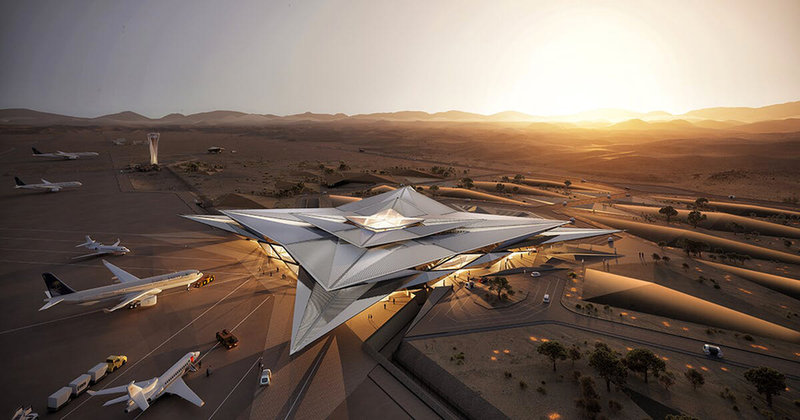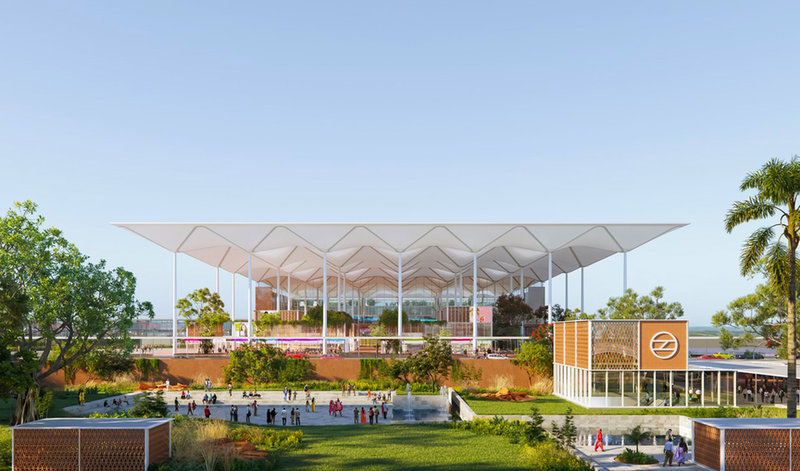Design
Climate change: airport expansion projects create bitter divides in architecture
A stark division has emerged among architects over whether to continue working on airport design projects, given the aviation sector’s emissions. What role does aviation play in the global clean energy transition, and are studios wrong to work on schemes that will expand airports’ global carbon footprint? Chris Lo reports.
Image: copyright
While the Covid-19 crisis has eclipsed virtually all other concerns for the airport and aviation sector in 2020, the global threat posed by climate change hasn’t gone anywhere.
The mass grounding of aircraft at the height of lockdowns might have brought the sector’s daily emissions down by as much as 60% (while also bringing the industry to the brink of collapse), but this carbon reprieve is a temporary one – a silver-lining by-product of a global pandemic that has claimed more than 1.5 million lives and wrought untold havoc on the global economy.
As the aviation sector begins its long road to recovery in 2021 – a year in which the global rollout of coronavirus vaccines has a strong chance of returning airports, and the world, to a semblance of normality – the ongoing discussions around global warming and aviation’s role in the decarbonisation process is as important as ever.
As one of the industries with the greatest influence over design standards and sustainability in the built environment, the architectural field has been particularly proactive in facing up to the environmental implications of the projects it undertakes for clients.
In May 2019, 17 Stirling Prize-winning architecture firms in the UK were the first signatories of Architects Declare (AD), committing to an 11-point list of principles to drive positive change in the industry’s working practices and participate in projects that will serve their function “without breaching the earth’s ecological boundaries”.
Since its establishment, more than 1,000 UK architects have signed up to the declaration, with over 5,000 signatories joining the global Construction Declares pledge.
Airport projects in the spotlight as AD loses two founding members
But while AD started as a unified front on sustainability from some of the UK’s most prestigious building designers, the group has started to fragment in late 2020 as diverging interpretations of AD’s guiding principles have emerged among the signatories.
Airport construction schemes – as high-intensity projects that contribute to the growth of an industry that accounts for around 2.5% of global CO2 emissions – lie at the heart of these increasingly acrimonious disagreements.
In early December – within a day of each other – two of AD’s highest-profile founding signatories, Foster + Partners and Zaha Hadid Architecture, announced that they had withdrawn from the network. Both of the studios have extensive experience in the design of airport terminals and facilities, and since signing up to AD have faced criticism for their ongoing involvement in major airport expansion projects.
Airport construction schemes lie at the heart of increasingly acrimonious disagreements
Foster + Partners has faced scrutiny this year for its design of a private international airport in Saudi Arabia, which will exclusively serve the Amaala luxury resort that is in development on the country’s northwestern coast. The new facility is scheduled to complete in 2023.
Zaha Hadid, meanwhile, saw the opening in September 2019 of the terminal building it designed for Beijing Daxing International Airport, the largest single-terminal airport in the world, and a month later the studio unveiled its design for the new Western Sydney Airport, which is due to launch in late 2026.

A render of Amaala Airport, being built in Saudi Arabia. Credit: Amaala
Architects divided over airports
AD’s environmental pledges don’t address airport construction schemes (or any particular project type) specifically, but they do include a commitment among signatories to “evaluate all new projects against the aspiration to contribute positively to mitigating climate breakdown, and encourage our clients to adopt this approach”.
For many fellow AD signatories in the architectural field, the continued involvement of studios like Zaha Hadid and Foster + Partners in airport projects runs counter to this pledge to measure new projects against their climate impact.
AD itself has made no direct criticisms of architects pursuing airport projects; the group has a ‘no name and shame’ policy, with “every signatory organisation expected to self-govern its progress towards achieving the commitments it has made”.
Only by internationally coordinated action can we confront the issues of global warming
Nevertheless, other critics have been quick to respond. In July, the Architects Climate Action Network (ACAN) sent an open letter to Foster + Partners, calling for the studio to quit the Amaala project and “pause your involvement in aviation expansion until such time as the sector has achieved carbon neutrality”, or otherwise to withdraw from AD “to safeguard the integrity and credibility of the initiative”.
Both Foster + Partners and Zaha Hadid have made statements explaining their reasoning for leaving AD. In a statement issued to Dezeen, Foster + Partners founder Norman Foster argued that “aviation, like any other sector, needs the most sustainable infrastructure to fulfil its purpose…together with the architects who can most responsibly design them”.
“Only by internationally coordinated action can we confront the issues of global warming and, indeed, future pandemics,” Foster said. “Aviation has a vital role to play in this process and will continue to do so. You cannot wind the clock backwards.”

Beijing Daxing International Airport in China. Credit: Arne Müseler
Should climate-conscious architects still be working on airport designs?
Studios that regularly provide designs and masterplans for airports have defended their work in the sector, pointing out design innovations and practices that are cutting emissions and energy consumption at modern airports.
The 5.61MW solar energy system installed at the Zaha Hadid-designed Beijing Daxi International Airport, which feeds energy into the grid and contributes to the airport’s use of renewables for 10% of its power, is a recent example.
Grimshaw Architects, which in December won a design competition for the passenger terminal of the in-development Delhi Noida International Airport, noted its design is targeting the highest rating under the LEED green building certification scheme, and that the terminal is aiming to achieve net-zero carbon operations.
Grimshaw is an AD signatory and said it would remain part of the declaration. But these incremental improvements are somewhat beside the point for studios that are more concerned by emissions from flights.
Sustainability and energy efficiency can be enhanced in building design, but participating in airport construction projects tied to wider aviation emissions is a sticking point in the disagreement and a more challenging prospect for architects as they have no control over this pollution.
For a climate-conscious architect to agree to work on a new or expanding airport, they are essentially putting their trust in airports and the aviation sector to rapidly accelerate the process of introducing greener fuels and drastically cutting air transport’s global emissions footprint.
For a climate-conscious architect to agree to work on a new or expanding airport, they are essentially putting their trust in airports
This trust was on full display in a November statement by Grimshaw, defending its airport work. “The same technological development which has fast-tracked aviation and made it more affordable, accessible and a catalyst for economic development can be expected to bring us the solutions to the environmental, social and cultural impacts of aviation, guided by the application of comprehensive design thinking,” the studio said.
The International Air Transport Association’s four-pillar strategy for decarbonisation incorporates improved technologies and the introduction of sustainable aviation fuels, more efficient aircraft operations, infrastructure upgrades and a single market-based measure to fill the remaining emissions gap.
This, the group argues, is how it will halve net CO2 emissions from aviation by 2050, compared to 2005 levels. But it’s clear that many architects have run out of trust that the transition is happening fast enough.
“Speculations around when or if aviation will decarbonise are irrelevant,” ACAN said in a December statement. “It is clear that this sector will not meaningfully decarbonise within the short window of ten years that scientists have given us to halve global carbon emissions.”
In survey data published by the network in July, 87% of respondents (drawn from ACAN’s membership) agreed with the statement that no UK architects should be working on airport expansion projects, at home or abroad.

A render of Delhi Noida International Airport. Credit: Grimshaw Architects
Pause or engage?
The controversy in architecture over taking aviation jobs lays bare a fundamental divide between the studios that believe the urgency of the climate crisis necessitates a total pause on airport contracts and those that believe providing architectural ideas and services is the best way to speed up the sector’s decarbonisation. And in late 2020 (when this piece was written), the battle lines appear to be sharply drawn.
“There remain signatory practices who appear determined to continue with business as usual,” AD warned in late November, a week before Foster + Partners and Zaha Hadid departed the group. “This is seriously undermining the effectiveness and credibility of Architects Declare, so we call on those practices to either join the wave of positive change or have the integrity to withdraw.”
Architects have no power over whether new airports will be built… But with design, they can have an effect on the impact of these projects
In a statement explaining its decision to withdraw, Zaha Hadid made particular note of this tension. “AD’s steering group has unilaterally decided on its own precise and absolute interpretation of the coalition’s commitments,” the studio said. “We need to be progressive, but we see no advantage in positioning the profession to fail. In fact, it would be a historic mistake.”
Architects have no power over whether new airports will be built, or whether existing airports will be expanded. But with design, they can affect the impact of these projects, and the environmental standards that will define the sustainability of airports in the future.
As such, in the 2020s and beyond, every design studio will have to decide, when considering whether to offer its expertise to an airport project, whether it’s better to tackle climate change by refusing to partner with carbon-intensive industries, or attempting to set new standards through engagement.
Main image credit: Shutterstock / Irina Lavrishcheva